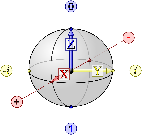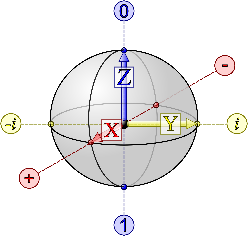









There are two major differences between qubits.
There is an ensemble qubit which contain a large number of particles that together act as a single qubit and there is what one typically thinks of as a qubit, which is a single particle or material.
Possible qubits include single photons, trapped atomic ions, neutral atoms, nuclear spins, quantum dots, impurities in silicon and diamond, etc...


WHAT IS A QUANTUM CLOUD COMPUTER?
Quantum computers truly do represent the next generation of computing. Unlike classic computers, they derive their computing power by harnessing the power of quantum physics. Because of the rather nebulous science behind it, a practical, working quantum computer still remains a flight of fancy.
Give clients access to a quantum computer over the internet, and you have quantum cloud computing. Currently the only organisation which provides a quantum computer in the cloud is IBM. They allow free access to anyone who wishes to use their 5 qubit machine. Earlier this year they installed a 17 qubit machine. So far over 40,000 users have taken advantage of their online service to run experiments.
Not to be outdone, Google are aiming to provide a quantum cloud computer in the next few years with 49 qubits.
So what is a qubit and how many do you need? Most experts would agree that you need at least 100 qubits before anything useful can be performed on a quantum computer. The only seller of quantum computers, D-Wave, has a current machine with 1,000 qubits and is working on another model with double that number of qubits. A viable quantum computer is still decades off, but promises a performance millions of times faster than a classic computer.
Qubit is short for a sequence of quantum bits. With a classic computer, data is stored in tiny transistors which hold a single bit of information, either the binary value of 1 or 0. With a quantum computer, the data is stored in qubits. Thanks to the mechanics of quantum physics, where subatomic particles obey their own laws, a qubit can exist in two states at the same time. This phenomenon is called superposition.
So a qubit can have a value of 1, 0, or some value between. Two qubits can hold even more values. Before long you are building yourself an exponentially more powerful computer the more qubits you add.

QUANTUM CLOUD
WHAT IS CLOUD COMPUTING?
Cloud computing is a means of networking remote servers which are hosted on the Internet. Rather than storing and processing data on a local server, or a PC's hard drive, one of the following three types of cloud infrastructure is used.
The first type is a public cloud. Here a third-party provider manages the servers, applications and storage much like a public utility. Anyone can subscribe to the provider’s cloud service, which is usually operated through their own data centre.
A business or organisation would typically use a private cloud. This might be hosted on their on-site data centre, although some companies host through a third-party provider instead. Either way, the computing infrastructure exists as a private network accessible over the Internet.
The third option is a hybrid cloud. Here private clouds are connected to public clouds, allowing data and applications to be shared between them. Private clouds existing alone can be very limiting, and a hybrid offers a business more flexibility. Often a hybrid cloud includes multiple service providers. Hybrids can offer more computing capacity for a business application when the need for it spikes. This sudden expansion into the public cloud is known as cloud bursting. Hybrids also enable applications to keep sensitive client data in a private cloud, but connect to end user software in a public cloud.
Cloud computing services can focus on infrastructure, web development or a cloud-based app. These are often regarded as a stack; all are on-demand, pay-as-you-go. Infrastructure as a Service (IaaS) gives you management of the whole deal: servers, web development tools, applications. Platform as a Service (PaaS) offers a complete web development environment, without the worry of the hardware that runs it. Finally, Software as a Service (SaaS) allows access to cloud-based apps, usually through a web browser interface. SaaS is the top of the stack.
Cloud computing has been around since 2000. Yet it’s only in the last 10 years that major players like IBM, Amazon and Google have offered commercially viable, high-capacity networks.
So what are the advantages of cloud computing? Well, much like with any utility - a business benefits from economy of scale, which means cheap computing power. Because a cloud provider’s hardware and software is shared, there’s no need for the initial costly capital investment. And it goes much further than that. Businesses save on the electricity required 24/7 to power and cool that computing infrastructure. In effect energy costs are shared.
It gets better. Cloud providers have vast resources of computing power at their fingertips. They can allocate these whenever required with just a few mouse clicks. Cloud providers source on a global scale, so they can deliver the precise bandwidth, storage and power a business needs when it needs it.
The cloud allows you and multiple users to access your data from any location. Smartphone, laptop, desktop, wherever you are, you can access the data you need at any time.
With cloud computing a business processes its data more efficiently, increasing productivity. Maintenance is much cheaper, often free, so reliability is rarely a worry. Cloud computing allows CEOs to focus on running their business.
REFERENCES:
- https://www.forbes.com/sites/aarontilley/2017/03/06/ibm-quantum-computing-cloud/#43cf540e77a2
- https://www.wired.com/2017/03/race-sell-true-quantum-computers-begins-really-exist/
- https://www.bloomberg.com/news/articles/2017-07-17/google-s-quantum-computing-push-opens-new-front-in-cloud-battle
- http://www.pcworld.com/article/3161034/computers/d-waves-quantum-computer-runs-a-staggering-2000-qubits.html
- https://www.newscientist.com/article/2130210-nanofridge-could-keep-quantum-computers-cool-enough-to-calculate/
- https://www.theregister.co.uk/2017/03/06/ibm_has_cloud_access_to_quantum_computer_400_times_smaller_than_dwave_system/
- https://en.wikipedia.org/wiki/Cloud_computing
- https://azure.microsoft.com/en-gb/overview/what-is-cloud-computing/
- https://www.ibm.com/cloud-computing/learn-more/what-is-cloud-computing/
Quantum computer theory was first rooted in the 1980s and only now are the first rudimentary machines being constructed. Quantum computers are big machines, reminiscent of the old mainframe computers of the 1960s. One serious logistical problem is the need for deep-freezing of the superconducting circuits. Only at sub-zero temperatures can the qubits maintain a constant, predictable superposition. Heating up qubits can result in calculation errors.
Getting a quantum computer to function usefully is an exciting prospect for scientists. Their gargantuan computing power would allow them to crunch very long numbers. They would be able to make complex calculations that would only overwhelm classic computers.
Accessing a cloud-based quantum computer combines the benefits of both technologies exponentially. Quantum computing could help in the discovery of new drugs, by unlocking the complex structure of chemical molecules. Other uses include financial trading, risk management and supply chain optimisation. With its ability to handle more complex numbers, data could be transferred over the internet with much safer encryption.
If some of the practical obstacles can be resolved, quantum cloud computing in years to come will become as far-reaching a technology as AI.












